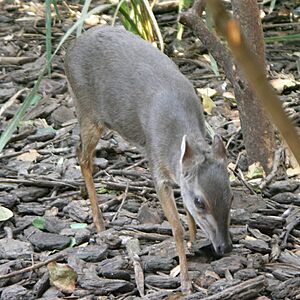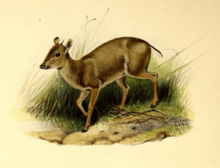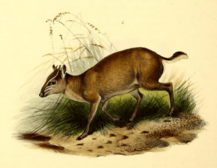Blue duiker facts for kids
Quick facts for kids Blue duiker |
|
|---|---|
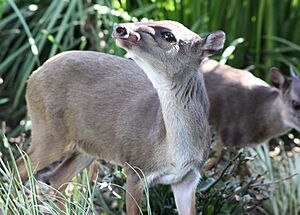 |
|
| Conservation status | |
| Scientific classification | |
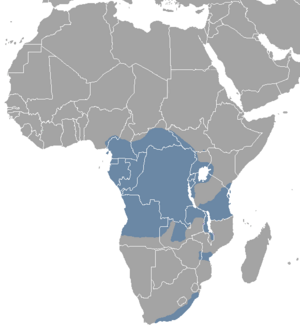 |
|
| Distribution map of Blue duiker | |
| Synonyms | |
|
The blue duiker (Philantomba monticola) is a tiny antelope that lives in the forests of central, southern, and eastern Africa. It is the smallest type of duiker, which is a group of small antelopes. A Swedish scientist named Carl Peter Thunberg first described this animal in 1789.
Blue duikers are quite small. They stand about 32–41 centimetres (13–16 in) tall at the shoulder and weigh between 3.5–9 kilograms (7.7–19.8 lb). Female blue duikers are usually a bit bigger than males. They have short, spiky horns, about 5 centimetres (2.0 in) long, which are often hidden by tufts of hair. Their dark tails are a little over 10 centimetres (3.9 in) long. Blue duikers can look very different in color depending on where they live.
Contents
Meet the Blue Duiker: What They Do
Blue duikers are active during the day. They are shy and careful animals, preferring to stay hidden in the edges of forests. They are also very territorial. A male and female duiker will form a pair and live together in their own area, which is about 0.4–0.8 hectares (0.0015–0.0031 sq mi) in size. They mark their territory using a special liquid from glands near their eyes.
What Do Blue Duikers Eat?
Blue duikers mostly eat fruits that have fallen from trees. They also munch on leaves, flowers, and pieces of bark. Sometimes, they even eat fungi, tree sap, and ants! They are good at finding food, sometimes by following birds and monkeys that drop fruit.
Blue Duiker Families: How They Reproduce
Scientists have different ideas about when blue duikers become old enough to have babies. Some say females can be ready by 8 months, while males take a bit longer, around 11 to 14 months. Blue duikers are monogamous, meaning a pair stays together for life.
A mother duiker carries her baby for about four to seven months. Babies can be born at any time of the year, but fewer are born during the dry season. A newborn calf can walk within 20 minutes of being born! The mother usually keeps her baby hidden. Babies drink milk for about 2.5 to 3 months.
Where Blue Duikers Live
Blue duikers live in many types of forests, including old forests, new forests, and forests along rivers. They love forests because the thick plants on the ground give them shelter, and the tree canopies provide food. They can be found from sea level up to 3,000 metres (9,800 ft) high.
You can find blue duikers in many African countries. These include Angola, Cameroon, Central African Republic, Democratic Republic of Congo, Equatorial Guinea, Gabon, Kenya, Malawi, Mozambique, Nigeria, Rwanda, South Africa, South Sudan, Tanzania, Uganda, Zambia, and Zimbabwe.
Understanding Blue Duiker Types
The scientific name for the blue duiker is Philantomba monticola. It belongs to a group of animals called Philantomba, which also includes Maxwell's duiker and Walter's duiker. All these animals are part of the Bovidae family, which includes cows, goats, and sheep.
The name monticola comes from Latin words meaning "mountain" and "I inhabit," because they live in hilly areas. The common name "blue" refers to their coat color, which can often have a bluish tint. The word "duiker" comes from an Afrikaans word meaning "diver," because these animals often dive into thick plants to hide.
Scientists have found many different types, or subspecies, of the blue duiker. They can be grouped into two main kinds based on their color and where they live:
Northern Blue Duikers (Grey-legged)
These duikers usually have grey to brown fur.
- P. m. aequatorialis: Found from the Democratic Republic of Congo to Uganda and near the Nile River.
- P. m. congicus: Lives from the Cross River to the Congo River, also in Cameroon and Gabon.
- P. m. lugens: Found in the Southern Highlands of Tanzania and possibly Malawi.
- P. m. melanorheus: Found on Bioko island in Equatorial Guinea.
- P. m. musculoides: Lives in eastern Ugandan and Kenyan forests.
- P. m. sundevalli: Found along the eastern African coast and on islands like Mafia, Pemba, and Zanzibar.
Southern Blue Duikers (Red-legged)
These duikers often have reddish-tan legs and reddish fur.
- P. m. anchietae: Found in northern Angola.
- P. m. bicolor: Lives from Zanzibar to the KwaZulu Natal region in South Africa.
- P. m. defriesi: Found in Zambia.
- P. m. hecki: Lives in Malawi, eastern Zambia, and northern Mozambique.
- P. m. monticola: Found in the Eastern Cape and Western Cape provinces of South Africa.
- P. m. simpsoni: Lives between the lower Congo River and its branch, the Kasai River.
How Blue Duikers Look
The blue duiker is the smallest type of duiker. Its body length is usually between 55 and 90 centimetres (22 and 35 in). They have flat foreheads, big eyes, small ears with white lines, and large nostrils. Their dark tails have a cool feature: a row of white, crinkly hairs that reflect light. When the duiker wags its tail, it looks like a bright signal in the dark forest!
They have special glands near their eyes and hooves that produce liquids. The liquid from the glands near their eyes is used to mark their territory.
Their fur color can be blue, grey, brown, or even black. The northern types are often grey to brown, while the southern types have reddish legs and coats.
Blue duikers look a lot like Maxwell's duiker. However, Maxwell's duiker is about twice as big and heavy. Also, blue duikers have more color variations than Maxwell's duikers.
Threats and How We Protect Them
The International Union for Conservation of Nature (IUCN) lists the blue duiker as "Least Concern." This means they are not currently in great danger of disappearing. They are also listed in Appendix II of CITES, which helps control their trade.
However, blue duikers are still threatened by hunting for bushmeat (meat from wild animals) in many areas. Their meat is an important food source for people in their habitat. Even with some human activity, blue duikers can often survive well in their environments.
Many protected areas help keep blue duikers safe. These include:
- Semuliki National Park (Uganda)
- Dja Faunal Reserve and Lobéké National Park (Cameroon)
- Dzanga-Sangha Special Reserve and Dzanga-Ndoki National Park (Central African Republic)
- Monte Alén National Park (Equatorial Guinea)
- Lopé National Park and Gamba (Gabon)
- Odzala, Nouabalé-Ndoki, and Conkouati-Douli National Parks, and the Lake Tele region (Congo-Brazzaville)
- The Okapi Wildlife Reserve and Maiko, Kahuzi-Biéga, and Salonga National Parks (Congo-Kinshasa)
- And many other protected areas in Southern Africa.
Images for kids
-
Blue duiker skeleton (Museum of Osteology)



